

This section details the approaches outlined in the previous section by focusing on their application in specific scenarios related to various hazards. The various mitigation strategies include:
These strategies are presented for specific hazards that were introduced in Module 2 (Risk Analysis) and include physical interventions and the use of specific technologies and systems.
The strategies are tailored to respond to specific types of cultural heritage, namely, historic buildings, vernacular or traditional settlements, historic areas and precincts, archaeological sites, cultural landscapes and movable heritage.
This section is best presented with a thematic focus, using lectures and case studies. A brief introductory matrix may be provided to participants outlining various hazards and their impacts. Detailed reading lists, technical pamphlets and resources as reference material should be circulated amongst participants.
The instructor can illustrate mitigation strategies and their advantages and disadvantages through secondary examples. These lectures can be closely linked to actual site visits if possible.
Flood prevention and Mitigation Techniques, Lecture 11, International Training Course 2011
Instructor: Yoshifumi Satofuka
Read More...
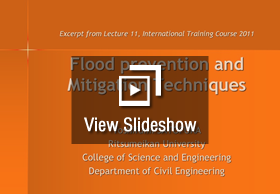
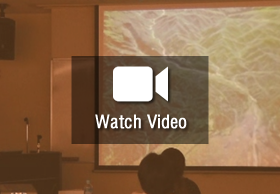
Seismic Performance of Japanese Historical Structures, Lecture 6, International Training Course 2011
Instructor: Kazuyuki Izuno
Read More...
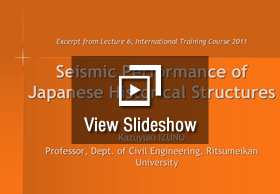
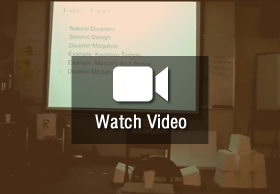
Landslide Prevention and Mitigation Techniques, International Training Course 2011
Instructor: Ryoichi Fukagawa
Read More...
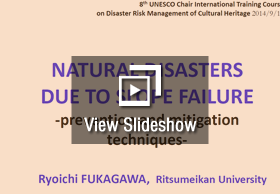
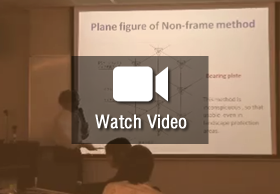
Planning Process and Project Management; Environmental Water Supply System for Protection of Wooden Cultural Heritages from Post-earthquake Fire, International Training Course 2011, 12
Instrcutor: Takeyuki Okubo
Read More...
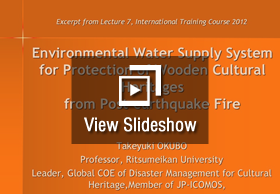
The site visit can be used to explain strength and weaknesses of various mitigation strategies and various technologies that are being used in various heritage sites. Based on the site visit, a workshop may be organised for participants.
The workshop should be designed to highlight relationships between specific hazards, cultural heritage and its components and mitigation strategies. It should be based on an actual site/ case study to ensure that participants are able to apply their theoretical understanding in a logical manner based on the identification of potential impacts of various hazards on cultural heritage. These could be based on the field observations in the workshop organised in the previous module on risk assessment.
Structural Vulnerability and Capacity of Historic Buildings in Patan Area and their Seismic Retrofitting Techniques, International Training Course 2009
Instructors: Kai Weise, Prem Nath Maskey, Rohit Jigyasu, Rohit Ranjitkar
Read More...

Study on The Tombs of Buganda Kings at Kasubi Tombs, Uganda, World Heritage Site, International Training Course, 2011
Participant: Remigius Kigongo
Read More...
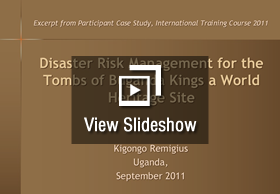
Sample Matrix (Indicative only)
Sample Matrix of Potential Actions
Among various combinations of hazard types, typology of cultural heritage and various types of mitigation measures the course organizers should chose those that are most relevant to their context and to the theme of the course.
Thematic Lectures Using Secondary Case Examples
The instructor can illustrate mitigation strategies and their advantages and disadvantages through secondary examples. These lectures can be closely linked to actual site visits if possible.
Site Visits
The site visit can be used to explain strength and weaknesses of various mitigation strategies and various technologies that are being used in various heritage sites. Based on the site visit, a workshop may be organised for participants.
Primary Case Study and Workshops
The workshop should be designed to highlight relationships between specific hazards, cultural heritage and its components and mitigation strategies. It should be based on an actual site/ case study to ensure that participants are able to apply their theoretical understanding in a logical manner based on the identification of potential impacts of various hazards on cultural heritage. These could be based on the field observations in the workshop organised in the previous module on risk assessment.


Flood prevention and Mitigation Techniques, Lecture 11, International Training Course 2011
Instructor: Yoshifumi Satofuka | Duration: 80 minutes
As a result of this session, participants were introduced to the following concepts:
The presentation highlighted through detailed diagrams and case studies the various types of floods as well as mitigation techniques. Diagrams are a simple graphical tool that helps participants retain the information introduced in the session.
The mechanism of a flood was explained.
Heavy rainfall over an extended period of time is one of the leading causes of large-scale devastation in various areas. In Japan, the configuration of the ground is very steep and the levels of precipitation are exceedingly high. In the events of fast falling and large-scale precipitation, extensive damage has occurred in the past, and is likely to happen in the future as well. Debris flow is one of the most dangerous phenomena in Japan. There has been extensive damage to life and property in a single event during the rainy season or as the result of a typhoon.
Floods may be classified into the following categories:
1. Flooding in a mild slope area.
2. Flooding in a steep slope area.
The various techniques to mitigate and prevent damage due to floods were listed:
1. Rainfall runoff control.
2. Flood control.
3. Drainage system development.
4. Land use regulation.
5. Anti-flood buildings and houses.
6. Hazard-maps and flood warning systems.

Monitoring systems for flood
Source: Yoshifumi Satofuka

Movement of soil as a result of heavy rainfall
Source: Yoshifumi Satofuka
 |
Monitoring systems for flood
Source: Yoshifumi Satofuka |
 |
Movement of soil as a result of heavy rainfall
Source: Yoshifumi Satofuka |
Seismic Performance of Japanese Historical Structures, Lecture 6, International Training Course 2011
Instructor: Kazuyuki Izuno | Duration: 60 minutes
This lecture presented an introduction to assessment techniques, investigation into past history of risks and disaster and examination of methods used to assess damage to structures (discussed in Module 2). Based on detailed risk assessment techniques, the instructor also introduced mitigation processes for buildings to be able to resist seismic activity.
The successive stages of the risk assessment module were also briefly discussed through the example of the Kiyomizu Temple.
The session highlighted the need to carefully assess and mitigate risks at the site. He illustrated in detail the difference between static and dynamic ways of testing for seismic performance of buildings and also the advantages of dynamic analysis.
The three modes of disaster reduction for timber buildings in Japan were introduced, namely:
Each mode was discussed in detail with several examples from buildings in Japan.

Landslide Prevention and Mitigation Techniques, International Training Course 2011
Instructor: Ryoichi Fukagawa | Duration: 80 minutes
Examples of slope failures and monitoring and recovery systems in Japan were highlighted by the instructor. Different conditions were explained, and priority based interventions for prevention, mitigation and recovery were listed. As a result of this session, participants were explained the characteristics of slope failures caused by earthquakes and heavy rainfall, typical prevention and mitigation methods for slope failures and be able to understand the advanced techniques for slope failure monitoring systems.
In Japan, natural disasters such as typhoons, heavy rainfall, and heavy snow have occurred because of geographical, topographical and meteorological conditions. Because of this there is a high risk from natural disasters due to earthquakes, heavy rainfall, and typhoons.
The following aspects of landslides were highlighted:
Typical methods of prevention and mitigation for slope failures
Control and emergency countermeasures including methods to control the movement of the slope by changing the natural conditions of topography, soil properties, and underground water flow, amongst others, were explained.
Slope stability monitoring systems in Kiyomizu-dera-temple (this case study was also part of a site visit made by the participants making it easier for them to relate to information). The work that the Geo-hazard Research group of Ritsumeikan University, which has been conducting field measurements in Kiyomizu-dera-temple in Kyoto was described briefly.
Stone wall damage investigation of Sendai Castle caused by the Tohoku-Taiheiyooki-Earthquake.
Field investigations have been carried out on damage to the stone walls of Sendai Castle caused by Tohoku-Taiheiyooki-Earthquake. The field investigations were conducted by mainly NSWS in-situ testing device, which is an improved device of the Swedish sounding test, and a three-dimensional laser scanning system.
Investigation of debris flow causing heavy damage to Kumano-Nachi-Taisha during Typhoon No.12 in 2011.
The secondary case example of typhoon No.12 in September 2011 was also used to illustrate slope analysis techniques. The typhoon caused severe damage to Kumano-Nachi-Taisha, one of the most significant shrines in the country. The shrine and its surrounding areas experienced record rainfall and the heavy rainfall resulted in the rush of debris flow and the failure of steep slopes. One of the debris flows damaged the Kumano-Nachi-Taisha. The geo-hazard group investigated the debris flow, especially the mechanical profile of the top, and carried out slope stability analysis using different technologies.
Reference:
Kazunari Sako, Ryoichi Fukagawa and Tomoaki Satomi (2011) Slope monitoring system at a slope behind an important cultural asset, Journal of Disaster Research, Vol.6, No.1, , pp.70-79.



Planning Process and Project Management; Environmental Water Supply System for Protection of Wooden Cultural Heritages from Post-earthquake Fire, International Training Course 2011, 12
Instructor:Takeyuki Okubo | Duration: 80 minutes
This lecture explained the planning process and management methods to develop an environmental water supply system (EWSS) for mitigating post earthquake fires. The concept of EWSS opens up possibilities for a sustainable water environment and the restoration of historical cities, maintaining beauty and safety for the benefit of future generations.
The methodology for developing EWSS was highlighted through the following steps:
The following secondary case examples of projects and management methods were used to supplement the lecture:
This lecture stated the need of practical planning for the optimum usage of various kinds of natural water in the Kiyomizu area to develop (EWSS) for disaster prevention. Such uninterrupted water supply systems could be used for fire prevention in historic cities that have a substantial number of wooden structures and thus preserve the historic urban environment.

Structural Vulnerability and Capacity of Historic Buildings in Patan Area and their Seismic Retrofitting Techniques, International Training Course 2009. Site: Patan, Kathmandu Valley
Instructors: Kai Weise, Prem Nath Maskey, Rohit Jigyasu, Rohit Ranjitkar | Duration: 60 minutes +180 minutes
Reducing Disaster Vulnerability of Traditional Housing
The workshop intended to introduce the participants to the basic methodology for the structural vulnerability assessment of traditional buildings in the historic town of Patan in the Kathmandu Valley, and applying this to the case study buildings. Each group was given specific structures in Patan. Each group collected data necessary to evaluate the structural condition and seismic performance of traditional buildings. This would include general characteristics, principle materials used, structural systems, building type, use and nature of occupancy, and architectural features that might affect seismic performance.
The groups then evaluated the structural vulnerability of the building. This included the load path system of the building, geometry, condition and performance of individual building elements, vertical discontinuities, mass of the building, openings in walls, characteristics of adjacent buildings and strength related evaluation. Weak and soft stories were identified in structures that may pose a serious risk to the building’s safety in the event of an earthquake. Adjacent structures were also documented for their potential impact. A tentative proposal for strengthening the building using traditional material and technology was prepared. Each group presented their findings followed by group discussion.




Study on The Tombs of Buganda Kings at Kasubi Tombs, Uganda, World Heritage Site, International Training Course, 2011
Participant: Remigius Kigongo
Background
The Kasubi Tombs in Uganda are a series of four tombs of the Buganda Kings inscribed as a UNESCO World Heritage Site. The unique architecture of the tombs set it apart as a cultural masterpiece associated with high intangible heritage value. The site is exposed to development pressures and is highly vulnerable to earthquake, wind, and fire. The structures constructed in traditional materials such as wood, grass, reeds and fibres are especially vulnerable to fire.
The participant focused on mitigating and reducing disaster risks to Kasubi tombs through organization, people and facilities as outlined below.

